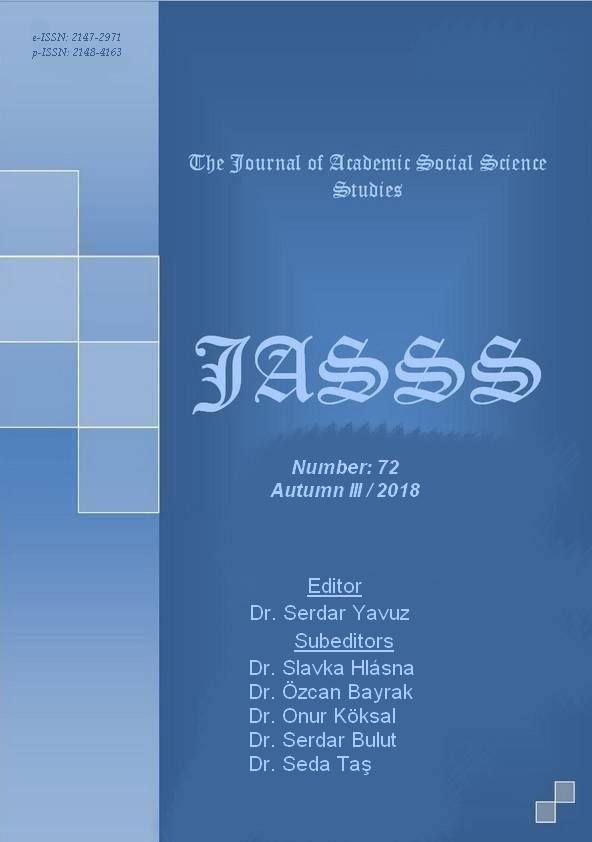Author :
Abstract
Bu araştırmanın amacı okul öncesi öğretmen adaylarının estetik kavramına ilişkin algılarını metaforlar aracılığıyla belirlemektir. Araştırma nitel araştırma yöntemlerinden olgu bilim (fenomenoloji) deseninde yürütülmüştür. Araştırmanın çalışma grubunu 2017-2018 öğretim yılında, Fırat Üniversitesi Eğitim Fakültesi Temel Eğitim Bölümü Okul Öncesi Eğitimi Anabilim Dalı’nda öğrenim gören 91 öğretmen adayı oluşturmaktadır. Veri toplama aracı olarak araştırmacılar tarafından oluşturulan iki aşamalı metafor formu tercih edilmiştir. Öğretmen adaylarından ‘Estetik…….e/a benzer çünkü…...’ şeklindeki iki aşamalı formu tek oturumda doldurmaları istenmiştir. Toplanan formlar nitel araştırma desenine uygun olarak içerik analizi yöntemi ile analiz edilmiştir. Çözümleme yapılırken öğrencilerin estetiğe ilişkin oluşturdukları metaforların benzetme yönleri temel alınarak temalar oluşturulmuştur. Temalar kendi içinde gruplanarak kavramsal kategorilere ulaşılmıştır. Metaforların ilgili kavramsal kategorileri temsil edip etmediği 4 farklı alan uzmanının görüşüne başvurularak teyit edilmiştir. Uzmanlardan alınan görüş ayrılığı ve görüş birliği sayıları kullanılarak araştırmanın uzman görüşü birliği %92 olarak hesaplanmıştır. Yapılan analiz sonucunda öğretmen adaylarının 57 farklı metafor ürettiği ve en fazla doğa ve çiçek metaforlarının tekrar ettiği görülmüştür. 8 kategori içinde en fazla güzel olma yönüyle estetik kategorisi (19) metafor içermektedir. Güzel olma yönüyle estetik kategorisini 19 metafor ile uyum ve denge içerme yönüyle estetik ve 15 metafor ile etkileyici olma yönüyle estetik kategorileri izlemektedir. Öğretmen adaylarının estetik kavramına ilişkin ürettikleri diğer metaforların huzur ve keyif verme yönüyle estetik (14), öznel olma yönüyle estetik (7), mükemmel olma yönüyle estetik (6), görsel olma yönüyle estetik (5) ve temel ihtiyaç olma yönüyle estetik (5) kategorileri olduğu sonucuna ulaşılmıştır. Okul öncesi öğretmen adaylarının estetik kavramını ağırlıklı olarak somut kavramlarla ilişkilendirdikleri ve benzetme yönlerinin estetik kavramına ilişkin alan yazın verileri ile paralellik gösterdiği tespit edilmiştir.
Keywords
Abstract
The aim of this study is to investigate the preservice preschool teachers’ perceptions of aesthetic via metaphors. Adopting a qualitative approach, phenomenological design was used in the study. The researchers developed a two phased metaphor questionnaire consisting of questions in the form of “Aesthetic is …. because ….”. The data were collected in 2017 – 2018 academic year from 91 preservice teachers studying at Firat University, Faculty of Education Department, Early Childhood Education. Content analysis was used in the analysis of data. Themes regarding to metaphors participants used was developed on the basis of their similarities. Then, conceptual categories were defined by grouping the themes. Expert opinion was used to ensure that the metaphors represented the conceptual categories. Expert consensus rate was found to be %92. The results revealed that the participants produced 57 different metaphors among which the metaphors of nature and flower were the most frequent ones. The aesthetic as beauty category (19) is the most frequent one among the 8 categories, followed by aesthetic as harmony and balance (19) and aesthetic as being impressive (15) categories. Other categories are as follows: metaphor as being delighting and calming (14), metaphor as being subjective (7), aesthetic as being perfect (6), aesthetic as being visual (5) and aesthetic as being essential (5). As a result, it is found that preservice preschool teachers associated the concept of metaphor with concrete conceptions and the assimilation of the participants were found to be similar to other studies in the literature.





